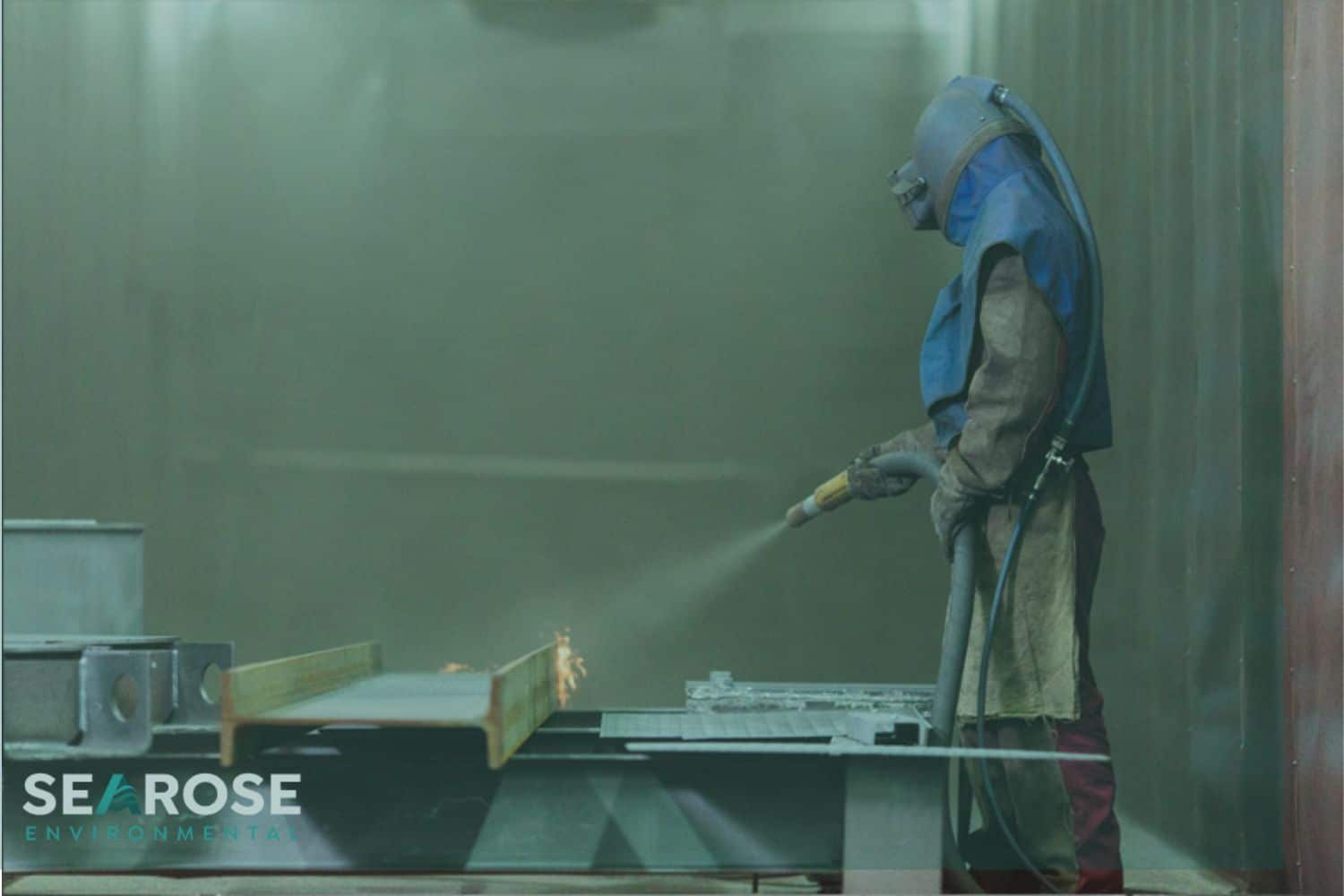Abrasive blasting, also known as sandblasting, is the process of utilising gritty or abrasive materials (traditionally sand particles) in a pressurised air or liquid medium to polish surfaces.
Commonly used in industrial settings such as painting, construction, metal finishing (and more), abrasive blasting is an extremely specialised process that requires the right expertise and safety procedures to be effectively carried out.
In this article, we’ll cover the common safety hazards encountered with abrasive blasting, as well as the related precautions that should be taken by both operators and workspace managers to minimise operational risks and increase efficiency.

Sandblasting safety hazards
Sandblasting can pose serious safety hazards for operating workers and others in the same vicinity, especially without use of the proper protective gear and equipment. Here are some of the most commonly encountered safety hazards posed by abrasive blasting:
- Respiratory issues
Dry abrasive blasting (using air as the primary medium) generates significant dust particles that cause serious repository issues when they are breathed in for extended periods of time. This is especially so regarding the use of silica sand — the resulting silica dust causes a condition known as silicosis, as well as lung cancer and a host of other breathing problems.
- Damage to eyes
During abrasive blasting, particles of dust often travel at high velocities. The danger is that these particles of dust are small enough to get into the eye, causing irritation, or worse end up scratching soft parts of the eye which can result in permanent damage to it as well as a loss of vision.
- Skin irritation and abrasion
Dust generated by abrasive blasting can enter into clothing without proper protective personal equipment (PPE) and cause skin irritations such as rashes. If the abrasive material comes into contact with skin at a high speed (such as from accidental positioning of the high pressure nozzle), it can cause significant damage to the skin and even become painfully embedded into the flesh.
- Chemical poisoning
Some industries may use toxic metals for abrasive blasting, which in turn create toxic dust that could lead to severe health conditions and death. Toxic metals like arsenic, cadmium, or beryllium can cause workers to develop heavy metal poisoning if these particles end up in their bloodstream, either through breathing or injury.

Abrasive blasting safety tips
Mitigating the risks of abrasive blasting should be a priority to reduce the likelihood of dangerous and potentially life-threatening workplace accidents.
SafeWork Australia has established a Code of Practice for abrasive blasting that outlines the important safety procedures and considerations that need to be in place to manage the risks involved. Here is a summary of the safety tips for abrasive blasting:
Ensure a safe environment
Given that abrasive blasting can generate harmful dust that lingers in the air, it should always be carried out in an enclosed chamber so as to isolate the contaminated air. This chamber should also be equipped with a dust extraction system to remove and filter out the dust particles in the air to create a safer working environment for operators.
It’s also important to maintain general cleanliness in the chamber to prevent the build-up of dust piles and debris that may impede the safe movement of operators.
Provide proper sandblasting safety equipment
All operators that carry out sandblasting should be provided with the appropriate PPE to ensure their personal safety. This includes:
- Helmets and eye protection
- Protective clothing (suit or jacket that covers the entire body)
- Airline respirators
- Protective gloves
- Protective footwear
- Personal hearing protection
This equipment is required to provide adequate protection for operators from the dangers posed by sandblasting and should be regularly maintained and kept in operable condition.
Invest in training for operators
Under the WHS Act, businesses are required to provide suitable training, instructions, and supervision for all operators and related personnel of abrasive blasting. Aside from the obvious fact that untrained staff should not operate dangerous equipment, investing in advanced training for abrasive blasting can also help operators work more efficiently while reducing the risk of workplace injuries.
H3: Establish strict safety procedures
Control measures such as workplace inspection and regular maintenance and monitoring should be put in place to protect the health and safety of all workers. Depending on the size and type of abrasive blasting carried out, operation managers must establish a clear safety procedure that covers how to avoid workplace injuries, and what to do when an accident does occur.

Use a safety checklist for abrasive blasting
The abrasive blasting process consists of many components. Each of these components should be kept in optimal condition using a safety checklist before operation.
- Check for cracks and other forms of damage in the chamber. Abrasive blasting stations must be secure enough to prevent leaks of contaminated air.
- Check the blast hose and any damage or jamming from lodged material.
- Rely on safer, organic abrasives. No abrasive media is completely harmless, but some will pose less harm than others, especially by eliminating the use of toxic materials.
- Test breathing filters and dust extraction or filtration systems on a daily basis. These are essential for maintaining proper ventilation within the area.
Find the right sandblasting solutions with Searose
At Searose Environmental, we are industry experts for abrasive blasting booth solutions in Queensland. If you require a custom abrasive blasting booth design or an effective dust extraction system to ensure greater safety for your workspace, contact our team of specialists today to find out how we can assist you.
